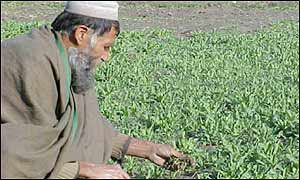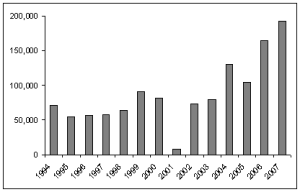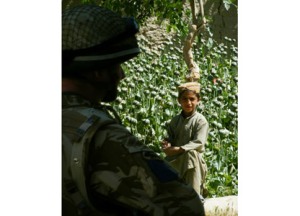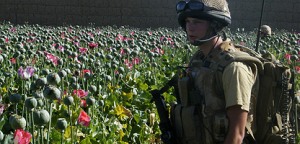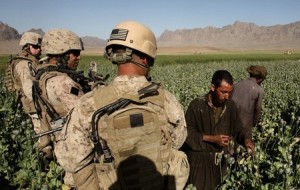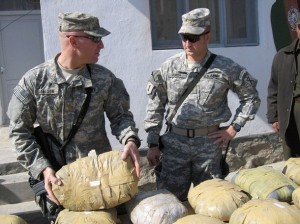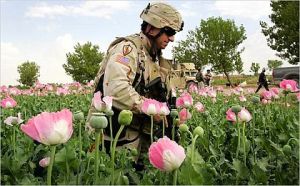Thought it was time to do a post on Heroin.
Seems we have a world wide epidemic now.
The profiteers are happy. Billions of dollars happy.
The addicts and those who have to deal with them, are not so happy.
The farmers who grow it do not make a lot of money, but everyone after them does. They make a fortune. Typical in the profiteering business however.
Troops are busy still Gurading the fields
U.S. Marines with Fox Company, 2nd Battalion, 5th Marine Regiment, Regimental Combat Team 6, patrol through a poppy field during Operation Lariat in the Lui Tal district, Helmand province, Afghanistan, April 16, 2012. The Marines conducted the operation to disrupt enemy logistics and establish a presence in the area. (U.S. Marine Corps photo by Lance Cpl. Ismael E. Ortega/Released)
Nov 5, 2012
$8.8M worth of heroin seized at Toronto airport-22 kg of the drug found in backpacks inside a box
Border services officers at Toronto’s Pearson International Airport noticed a suspicious package unloaded from a plane from Pakistan last week and found 22 kilograms of heroin hidden inside.–For the rest of the story go HERE
Nov 5, 2012
Heroin user infected with anthrax in Oxford
2012
Case is the 12th in Europe since June and follows two deaths in Blackpool- For the rest of the story go HERE
Some soldiers are becoming addicts.
Addiction in the Ranks, Soldiers and Heroin
Canada faces flood of Heroin and Addicts
December 12, 2010
Treatment centres in cities around Canada are struggling to cope with a surge of addicts — many younger than ever before — who are hooked on a rising tide of heroin pouring into this country from war-torn Afghanistan. For the rest of the story go HERE
Mar 12, 2010
By Kevin Hayden
For relatively pure heroin, cultivated and shipped from Afghanistan, the world’s largest supplier of heroin – it would net you $19,923,200 USD PER BARREL.
Now, by the time that hits American and Russian streets…and is cut up and diluted several times, you are looking at roughly $60,000,000 – $80,000,000 US dollars per barrel of heroin.
For the rest of the story go HERE
From 2009
Then we have the Soldiers making sure the poppy fields are safe.
A few pictures as well as reports.
Afghanistan: Troops Guarding the Poppy Fields
CIA, Heroin Still Rule Day in Afghanistan
December 1, 2008
By Victor Thorn
Afghanistan now supplies over 90 percent of the world’s heroin, generating nearly $200 billion in revenue. Since the U.S. invasion on Oct. 7, 2001, opium output has increased 33-fold (to over 8,250 metric tons a year).
The U.S. has been in Afghanistan for over seven years, has spent $177 billion in that country alone, and has the most powerful and technologically advanced military on Earth. GPS tracking devices can locate any spot imaginable by simply pushing a few buttons.
Still, bumper crops keep flourishing year after year, even though heroin production is a laborious, intricate process. The poppies must be planted, grown and harvested; then after the morphine is extracted it has to be cooked, refined, packaged into bricks and transported from rural locales across national borders. To make heroin from morphine requires another 12-14 hours of laborious chemical reactions. Thousands of people are involved, yet—despite the massive resources at our disposal—heroin keeps flowing at record levels.
Common sense suggests that such prolific trade over an extended period of time is no accident, especially when the history of what has transpired in that region is considered. While the CIA ran its operations during the Vietnam War, the Golden Triangle supplied the world with most of its heroin. After that war ended in 1975, an intriguing event took place in 1979 when Zbigniew Brzezinski covertly manipulated the Soviet Union into invading Afghanistan.
Behind the scenes, the CIA, along with Pakistan’s ISI, were secretly funding Afghanistan’s mujahideen to fight their Russian foes. Prior to this war, opium production in Afghanistan was minimal. But according to historian Alfred McCoy, an expert on the subject, a shift in focus took place. “Within two years of the onslaught of the CIA operation in Afghanistan, the Pakistan-Afghanistan borderlands became the world’s top heroin producer.”
Soon, as Professor Michel Chossudovsky notes, “CIA assets again controlled the heroin trade. As the mujahideen guerrillas seized territory inside Afghanistan, they ordered peasants to plant poppies as a revolutionary tax. Across the border in Pakistan, Afghan leaders and local syndicates under the protection of Pakistan intelligence operated hundreds of heroin laboratories.”
Eventually, the Soviet Union was defeated (their version of Vietnam), and ultimately lost the Cold War. The aftermath, however, proved to be an entirely new can of worms. During his research, McCoy discovered that “the CIA supported various Afghan drug lords, for instance Gulbuddin Hekmatyar. The CIA did not handle heroin, but it did provide its drug lord allies with transport, arms, and political protection.”
By 1994, a new force emerged in the region—the Taliban—that took over the drug trade. Chossudovsky again discovered that “the Americans had secretly, and through the Pakistanis [specifically the ISI], supported the Taliban’s assumption of power.”
These strange bedfellows endured a rocky relationship until July 2000 when Taliban leaders banned the planting of poppies. This alarming development, along with other disagreements over proposed oil pipelines through Eurasia, posed a serious problem for power centers in the West. Without heroin money at their disposal, billions of dollars could not be funneled into various CIA black budget projects. Already sensing trouble in this volatile region, 18 influential neo-cons signed a letter in 1998 which became a blueprint for war—the infamous Project for a New American Century (PNAC).
Fifteen days after 9-11, CIA Director George Tenet sent his top-secret Special Operations Group (SOG) into Afghanistan. One of the biggest revelations in Tenet’s book, At the Center of the Storm, was that CIA forces directed the Afghanistan invasion, not the Pentagon.
In the Jan. 26, 2003, issue of Time magazine, Douglas Waller describes Donald Rumsfeld’s reaction to this development. “When aides told Rumsfeld that his Army Green Beret A-Teams couldn’t go into Afghanistan until the CIA contingent had lain the groundwork with
local warlords, he erupted, ‘I have all these guys under arms, and we’ve got to wait like little birds in a nest for the CIA to let us go in?’”
ARMITAGE A MAJOR PLAYER
But the real operator in Afghanistan was Richard Armitage, a man whose legend includes being the biggest heroin trafficker in Cambodia and Laos during the Vietnam War; director of the State Department’s Foreign Narcotics Control Office (a front for CIA drug dealing); head of the Far East Company (used to funnel drug money out of the Golden Triangle); a close liaison with Oliver North during the Iran-Contra cocaine-for-guns scandal; a primary Pentagon official in the terror and covert ops field under George Bush the Elder; one of the original signatories of the infamous PNAC document; and the man who helped CIA Director William Casey run weapons to the mujahideen during their war against the Soviet Union. Armitage was also stationed in Iran during the mid-1970s right before Ayatollah Ruhollah Khomeini overthrew the shah. Armitage may well be the greatest covert operator in U.S. history.
On Sept. 10, 2001, Armitage met with the UK’s national security advisor, Sir David Manning. Was Armitage “passing on specific intelligence information about the impending terrorist attacks”? The scenario is plausible because one day later—on 9-11—Dick Cheney directly called for Armitage’s presence down in his bunker. Immediately after WTC 2 was struck, Armitage told BBC Radio, “I was told to go to the operations center [where] I spent the rest of the day in the ops center with the vice president.”
These two share a long history together. Not only was Armitage employed by Cheney’s former company Halliburton (via Brown & Root), he was also a deputy when Cheney was secretary of defense under Bush the Elder. More importantly, Cheney and Armitage had joint business and consulting interests in the Central Asian pipeline which had been contracted by Unocal. The only problem standing between them and the Caspian Sea’s vast energy reserves was the Taliban.
Since the 1980s, Armitage amassed a huge roster of allies in Pakistan’s ISI. He was also one of the “Vulcans”—along with Condi Rice, Paul Wolfowitz, Richard Perle, and Rabbi Dov Zakheim—who coordinated Bush’s geo-strategic foreign policy initiatives. Then, after 9-11, he negotiated with the Pakistanis prior to our invasion of Afghanistan, while also becoming Bush’s deputy secretary of state stationed in Afghanistan.
Our “enemy,” or course, was the Taliban “terrorists.” But George Tenet, Colin Powell, Porter Goss, and Armitage had developed a close relationship with Pakistan’s military head of the ISI—General Mahmoud Ahmad— who was cited in a Sept. 2001 FBI report as “supporting and financing the alleged 9-11 terrorists, as well as having links to al Qaeda and the Taliban.”
The line between friend and foe gets even murkier. Afghan President Hamid Karzai not only collaborated with the Taliban, but he was also on Unocal’s payroll in the mid-1990s. He is also described by Saudi Arabia’s Al-Watan newspaper as being “a Central Intelligence Agency covert operator since the 1980s that collaborated with the CIA in funding U.S. aid to the Taliban.”
Capturing a new, abundant source for heroin was an integral part of the U.S. “war on terror.” Hamid Karzai is a puppet ruler of the CIA; Afghanistan is a full-fledged narco-state; and the poppies that flourish there have yet to be eradicated, as was proven in 2003 when the Bush administration refused to destroy the crops, despite having the chance to do so. Major drug dealers are rarely arrested, smugglers enjoy carte blanche immunity, and Nushin Arbabzadah, writing for The Guardian, theorized that “U.S. Army planes leave Afghanistan carrying coffins empty of bodies, but filled with drugs.” Is that why the military protested so vehemently when reporters tried to photograph returning caskets? Source
A war for drugs.
Afghanistan’s Opium Trail, Documentary.
CBC Passionate Eye
Afghanistan – 10 Years of Failure & Oppression [Documentary]

Afghan children work in a poppy field in the area of Karez-e-Sayyidi, Helmand province, April 2010. REUTERS/Asmaa Waguih
Afghanistan’s Child Drug Addicts
A little History
Secrets of the CIA
“The CIA is a state-sponsored terrorists association. You don’t look at people as human beings. They are nothing but pieces on the chessboard.” — Verne Lyon, former CIA agent in revealing documentary.
The UN Report documents how the world’s deadliest drug has created a market worth $65 billion, catering to 15 million addicts, causing up to 100,000 deaths per year, spreading HIV at an unprecedented rate.
You can thank the US invasion of Afghanistan for the problem.
Here there is a Map on drug use world wide. It was created using the statistics from the UN Report. It is not complete as there is nothing about Heroin use in Canada which of course is wrong, There are Heroin Addicts in Canada. But it does give you a good idea how wide spread the problem is. You can change the type of drug you want to look at on a world wide scale. Choices are Cannabis, Cocaine, Ecstasy, Amphetamines, Opiates/Heroin
This map Can give a lot of details on Drug seizures.You can segregate by drug.
If you put in Heroin and Opium it is rather interesting.
Better still scroll down a bit and there is another Search you can do. “Search Events”, Try putting in the details you want. You can do it for a certain country and certain dates etc. So I put in Heroin and Opium. I choose dates from 2000 to now. I included all countries. There sure is a lot of Heroin and Opium out there.
I found that the info only goes back to 2009. Even so it is very informative.
The information is only the ones that were caught. So one can only imagine how much more is out there. Odds are there are also many events that are not listed. Finding them all would take lot of time. Whoever runs the site has done an excellent job however.
Recent
Fugitive Nathan Jacobson, a friend of Harper, you decide
Turkey: Jailing is the Agenda to silence critical Journalists
Updated November 3rd -Canada: Coroner’s Inquest of Ashley Smith’s death in Prison
Japan: Radioactive cesium levels in most fish has not declined
//

